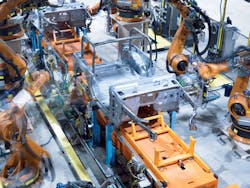Factoring Safety into Factory Controls
It allows simplifying safety systems and integrating them much more efficiently with the controls, as KUKA Toledo Productions Operation LLC proved in its body-in-while assembly plant for Jeep JK vehicles in Toledo, Ohio. Moving from a hardwired safety system to one that is software based allowed it to cut the safety components on the line by 85 percent.
This reduction was not a trivial feat for a line equipped with 245 robots and staffed by 240 employees working two shifts per day. The conventional way of building safety into such lines usually consisted of installing fences, emergency stops, gate switches, mats, light curtains and a multitude of redundant relays. Then, an extensive network of hardwired circuits, each wired redundantly, would link the components together.
Not only was this design plagued with inflexibility and fraught with communication delays, but it also was expensive to install and troubleshoot. KUKA avoided these problems by migrating to a safety programmable logic controller (PLC) and by putting it and the machine controls onto one fieldbus from automation supplier Siemens Industry Inc., of Alpharetta, Ga. The Profibus-based processor both controls the normal operation of the machine and oversees the safety devices.
The move permitted system designers to work in just one programming environment and use ladder logic for both process control and safety, which reduced engineering time. After they designed and configured the hardware, the designers were able to generate most of the software safety blocks automatically using a safety solution from Siemens.
“This reduces extra code that would otherwise need to be written by the user to do safety checks and balances,” says John D’Silva, Siemens’ business development manager for safety integration. “This also enables the user to focus on the code that is required to be written for the application.”
After users finish writing the safety code using the appropriate wiring models, the safety system checks the result. Only then are users permitted to download the program into the safety controller. “Following the model is very important to achieve the required safety level,” stresses D’Silva.
Related Feature - Moving from Models to Control Code
To read the feature article relating to this story, go to http://www.automationworld.com/feature-8232.

